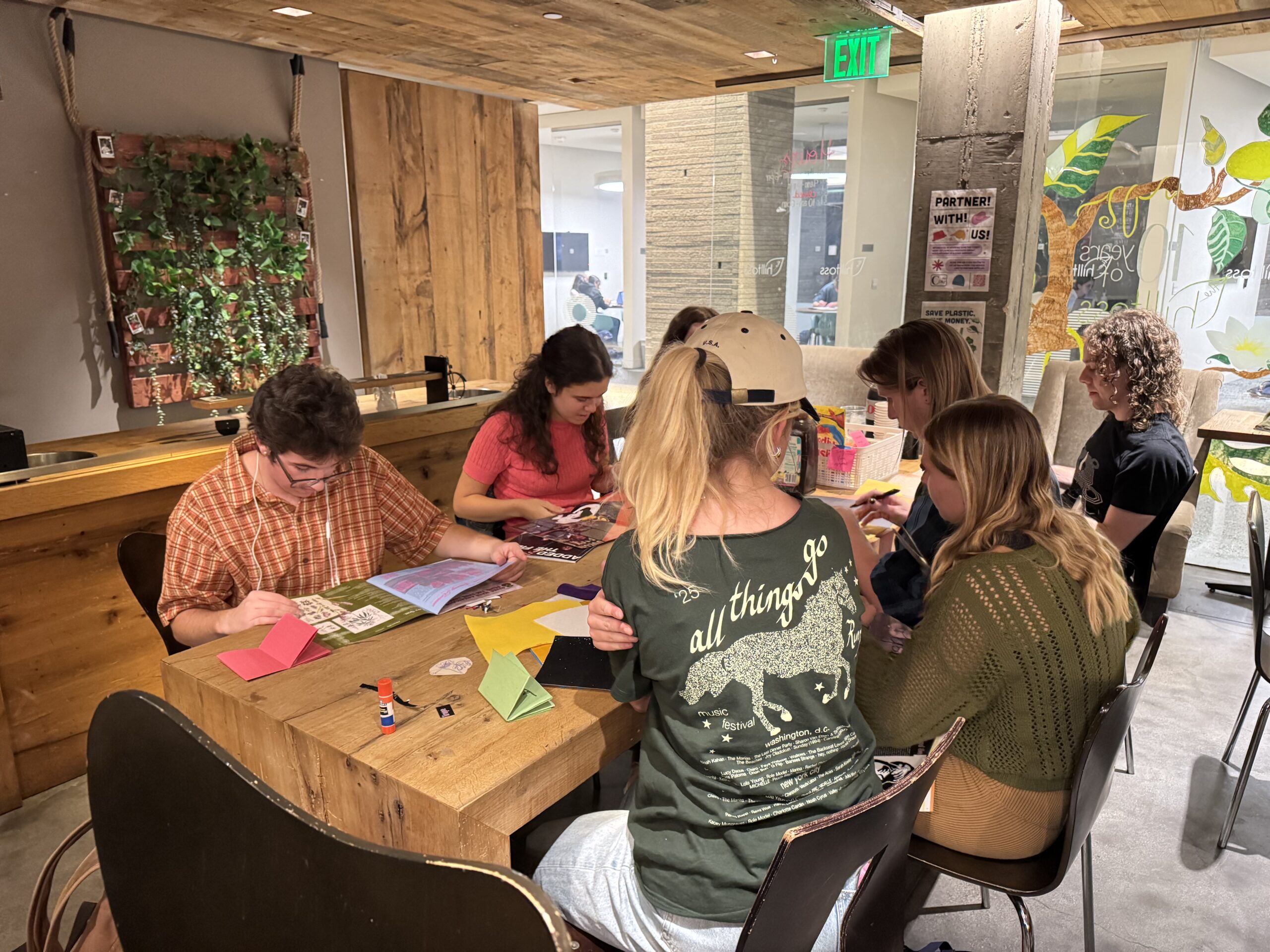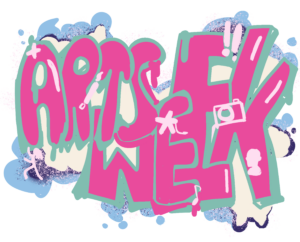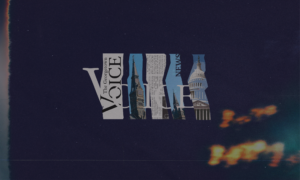The lights went low. Chill beats were on. Glue, scissors, and snacks were at the ready. It was an hour past closing, yet students were still gathered in the Hilltoss Cafe at 7 p.m. with one objective: Zine night.
Cutting, pasting, and crafting little maga(zine)s from old issues of The Indy and the Voice, Zine night welcomed all who relished the opportunity to create at Georgetown. Saniya Bhagwat (SFS ’28) and her friends were proud attendees. Bhagwat appreciated that the zines used art her classmates designed.
“I feel like people don’t typically think of arts when they think of Georgetown,” Bhagwat said. “I thought it was really cool that we had something that sends the message that, yeah people are creative here, they express themselves.”
The night was one of many events that GUSA hosted at its second Arts Week. Running from Monday, Sept. 29 until Sunday, Oct. 5, GUSA and other clubs paired up to present different opportunities for Georgetown students to engage with the Hilltop creatively, ranging from a gallery in Lauinger to an arts fair in Red Square.
Tina Solki (SFS ’26) is a GUSA senator for the senior class. This is her second semester unofficially chairing the Arts Week committee.
“A lot of this has been a very self-directed project,” Solki said. “I’ve been really proud of what we’ve been able to do.”
Solki took some time to find her place on Georgetown’s campus, until she found an opportunity to showcase her art by designing covers for the Voice. She found her place in the art that friends and strangers hung on their walls.
“I hadn’t done that through landing the right internship or through having some fancy title,” Solki said. “I had just done that through embracing the art that I had loved my whole life.”
At this point in the semester, students have received news of whether or not they were accepted into the highly exclusive club of their dreams. Regardless of the results, Solki said that underclassmen, in particular, are just looking for ways to spend their time and meet new people.
“I am really conscious of how pre-professional the school is and how that can lead students whose main interests have been the arts to feel cornered into marketing,” Solki said. “The goal of Arts Week isn’t necessarily to create new structures, but to just highlight what already exists and to try and help platform the immense amount of talent, creativity, and opportunity on this campus.”
Unlike last semester’s Arts Week, this year’s event has a fundraising beneficiary. Solki reached out to the Sitar Arts Center, a community-based nonprofit working to provide affordable art programming for low-income youth in the D.C. area.
Selling prints and shirts showcasing students’ artwork not only generated exposure for artists, but also raised funds for Sitar.
“We are just so grateful for all the support of the students here at Georgetown,” Jessica Leskin, Sitar’s director of institutional giving, said. “We’ve been getting so many donations from the postcards and the drawings and it really makes our mission possible,”
Ringing in October was the H*yas for Choice (HFC) magnet-making, cookie-baking “Get Baked” celebration. For one crafty student, this was just another stop on her arts week tour.
Sophia Rauenhorst, (CAS ’29), a first-time arts week participant and member of HFC, arrived at the event directly after her participation in the Iranian Cultural Society’s “Chai & Paint” party. She was accompanied by a friend she had made while sipping The Corp’s chai and relaxing after a long chemistry exam.
For Rauenhorst, the opportunity to unwind with light refreshments and a newfound community was exactly what she needed. She connected with members of HFC in a new, low-pressure environment. While she meticulously molded clay into miniature vegetables, she noted that she wouldn’t call herself an artist, but simply a student looking to have fun and decompress.
“There’s just something about the act of creating where even if the end result isn’t necessarily museum worthy, it’s just so much fun,” Rauenhorst said. “This was very soul healing.”
As a new Hoya away from home, Rauenhorst is still discovering who she is on the Hilltop. She the importance of light-hearted activities to offset the stress college students face.
Referring to herself and her peers as “kids,” she notes that students need opportunities to return to their finger-painting-filled academic roots.
“I’m doing a lot of reckoning with identity and adulthood as all my freshmen are,” Rauenhorst said. “And this is very much a kind of back to basics and it’s something very familiar.”
While Solki described exploring creative outlets at Arts Week as a break from pre-professional culture, Rauenhorst doesn’t think the two are mutually exclusive.
“I don’t really feel like it’s part of a stereotype or against a stereotype,” Rauenhorst said. “It feels just like another part of the whole.”
Preparing to bake her vegetable garden of magnets, Rauenhorst moved back to the counter of Arrupe’s kitchen to add some final touches. Her fellow HFC members professed their admiration for her comically-sized carrot and eggplant models.
After such a successful day of arts week participation, Rauenhorst eagerly shared her excitement for the upcoming embroidery session with Students for Justice in Palestine that Friday.
Olivia Baine, HFC’s director of development, pulled out the adorable-yet-smelly first round of clay magnets from the oven. Immediately brightening the scent was the next tray she grabbed, filled with freshly-baked cookies.
Baine expressed her surprise at the creative talent of her fellow HFC members, seeing them in an artistic environment atypical for club events. With a turnout of over 20 people, she took the event as a success. She also noted the status of HFC, making this event even more exciting for the club.
“We were really happy to have GUSA reaching out and to be involved with them, because we’re not endorsed by the school,” Baine said. “So it means a lot when GUSA reaches out.”
HFC was one of over 20 clubs collaborating with GUSA this arts week. With extracurriculars ranging from political activism to journalism to promoting student art, the diverse array of student organizations participating was a highlight for Baine.
“Every single club has something nuanced to add,” Baine said.
Painter Lindsay Khalluf (CAS ’26) was able to participate in arts week both years since its revival. Coming to Georgetown, she missed the collaboration in the arts that she had in high school. This inspired her to start ADDED TO THE FILE (ATTF), Georgetown’s fashion magazine, in her sophomore year to create a new, accessible space to make art with others.
“Every part of it is made by at least five people—literally each page,” Khalluf said. “The people at this campus were way more creative and into the arts than you would think.”
Many students don’t plan on studying art like Khalluf does. But during arts week, Khalluf recognized many of her classmates she never realized were artists.
“A lot of people really like creative things here. They just happen not to be a studio art major,” Khalluf said. “It’s really great to have initiatives like this that are community based and that are integrated in the rest of Georgetown beyond just Walsh and the painting studios.”
Having her own pieces on Lau 2 was exciting for Khalluf, who had never had her pieces on display before in a gallery-like space. The exhibition was located in the middle of the floor, easily allowing students to take notice of the work, like one piece Forgive Me that was showcased right as you entered.
“A bunch of people get to be involved with art that is normally so confined to a very small community on campus,” Khalluf said. “It makes the art something that’s now not just in my internal world—it’s really great to know that other people have a relationship with it as well.”
While most students finish their descent into Lau on floor two for a cup of coffee or some half-minded studying, hidden in a quiet corner of the first floor is a photography studio. Here is where ATTF shoots their photos and where Madeline Burns (CAS ’26) hosted the magazine’s “Fashion Photography 101” class.
Over the course of an hour and a half, Burns clicked through a presentation educating her audience on camera basics, lighting equipment, and intentional composition, pausing to snap a shot of ATTF model Manya Dyer (SFS ’26) every few minutes.
Burns hoped the workshop would help students feel less intimidated by photography and its many technicalities.
After talking through the ins and outs of ISO and the rule of thirds, Burns gave attendees the freedom to play. New photographers adjusted the studio’s lighting, directed the models, and even included a small pumpkin prop Burns brought along to welcome in the fall season.
As members of the ATTF photography team popped in and out to listen, offer advice, and chat about life in between classes, the team’s closeness was on full display. This community played a large part in the magazine’s founding.
“Us at ADDED TO THE FILE, we started because we were looking for a creative community on campus that we didn’t really think was here. It was a group of a bunch of creative students that wanted that creative outlet,” Burns said.
The community Burns helped to build is not exclusive to those interested in photography. ATTF pulls in artists for photography, graphic design, fashion, and writing.
Solki emphasized Arts Week’s ability to highlight the creativity that already exists on campus, pairing with clubs like ATTF to spotlight different artistic outlets.
“I think there are a lot of really lovely spaces on campus for people to get involved with the arts for the sake of the arts, for the sake of expressing their creativity,” Solki said. “A lot of people just don’t know that they exist.”
Editor’s note: Tina Solki is a member of the Voice‘s editorial board and previously served as the newsmagazine’s design editor.




